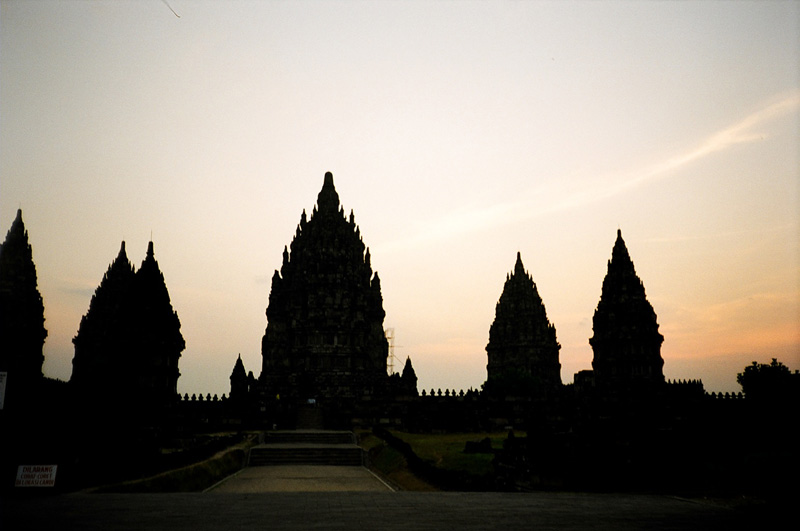Yogyakarta: "Return to Yogya"
Yogyakarta
Central Java
May 22, 2005
Dear Family and Friends,
I had to leave Bandung. I wanted to stay a day or two longer. I was enjoying the sights and my new friends. But my chest was heaving, my eyeballs burning, my whole system in rebellion. The pollution so intense.
I boarded the early morning train, rode through the mountains and water-logged fields of rice. That afternoon, I returned to Yogya and my "home" at the Duta Garden Hotel.
"Garden" it is. All the spacious, comfortable guest rooms have a large terrace that overlooks the "tropical" style swimming pool. Plants and trees are everywhere. A waterfall at one end of the pool. Tea is served on the terrace in the afternoon.
Am I tempted to just relax? I am. But I cannot. Too much to see and time is growing short.
First, Prambanan nearby.
"On the road to Solo, 17km east of Yogya, the temples of Prambanan village are the cream of what remains of Java's period of Hindu cultural development. Not only do these temples form the largest Hindu temple complex of Java, but the wealth of sculptural detail on the great Shiva Temple makes it easily the most outstanding example of Hindu art."
All of the temples were built between the 8th and 10th centuries. They combine both Hindu and Buddhist elements of architecture and sculpture.
I felt I was visiting some old "friends" - Shiva, Sita, Hanuman, Sugriwa, Agasta, Ganesha. I made one new "friend" - the tragic Loro Jonggrang. Listen:
"Shiva Mahadeva Temple. Dedicated to Shiva, this is not only the largest of the temples, it is also artistically and architecturally the most perfect. The main spire soars 47m high and the temple is lavishly carved. The 'medallions' which decorate its base have the characteristic 'Prambanan' motif - small lions in niches flanked by 'trees of heaven (kalpaturas) and a menagerie of stylized half-human and half-bird heavenly beings (kinnaras)."
"The vibrant scenes carved into the inner wall of the gallery encircling the temple are from the Ramayana. They tell how Lord Rama's wife, Sita, is abducted and how Hanuman the monkey god and Sugriwa his white monkey general eventually find and release her."
"In the main chamber, the four-armed statue of Shiva the Destroyer is notable for the fact that this mightiest of Hindu gods stands on a lotus pedestal, a symbol of Buddhism."
"In the southern cell is the pot-bellied and bearded Agastya, an incarnation of Shiva as divine teacher; in the western cell is a superb image of the elephant-headed Ganesha, Shiva's son."
"In the northern cell, Durga, Shiva's consort, can be seen killing the demon buffalo. Some people believe that the Durga image is actually an image of Loro Jonggran, the 'Slender Virgin' who, legend has it, was turned to stone by a giant she refused to marry. She is still the object of pilgrimage for many who believe in her, and the name of the cursed princess is often used for the temple group."
I visited the main temple group of the Prambanan Archaeological Park in the late afternoon. The setting sun coated the carvings with a patina of golden yellow.
After all these months, I have finally followed the advice of other travelers. Sunrise and sunset are the best times to visit temples and monuments. Fewer tourists and tour groups. (Well, not always, especially at sunrise.) Better sun for photos. Fewer vendors. A more colorful experience.
And, speaking of sunset and Ramayana, on my first visit to Yogya, ten days ago, Utami and I attended the opening night of the Ramayana ballet. Lucas knows someone, so we also had a peek at the dressing rooms. And at the end of the performance, the audience was encouraged to pose for photos with the accommodating cast.
The ballet itself is a spectacle. The outdoor theater has the magnificent flood-lit Shiva Mahadeva Temple as a backdrop. Dozens of dancers and musicians act out the Ramayana epic of abduction, pursuit, clash and redemption. A colorful and dramatic evening under the black Java sky.
And, as I plan my final days here, I am hoping for much more color and drama as I head east to the volcanoes of Mt. Bromo National Park.
Now, it's back to the Duta Garden Hotel and an early morning departure to East Java.
Cheers,
Jan
By the way, I "borrowed" the phrase "Return to Yogya" from the title of the tape that Lucas played in his car. At first I was entranced by the soulful traditional music. But as we listened to the tape again and again (Lucas had only this one tape!) something bothered me. The sound of the flute was too perfect.
At first I thought, what a talented player. But there was no vibrato or any deviation from perfect pitch. Strange, I thought.
When I found the CD at a market, I got the answer. On the cover of the CD was a photo of a digital keyboard!
Digital - perfect music. I decided not to buy the CD. I am still a Twentieth Century man. Call me crazy. I like acustic music. I like music played by real people. I like "Real" music.

